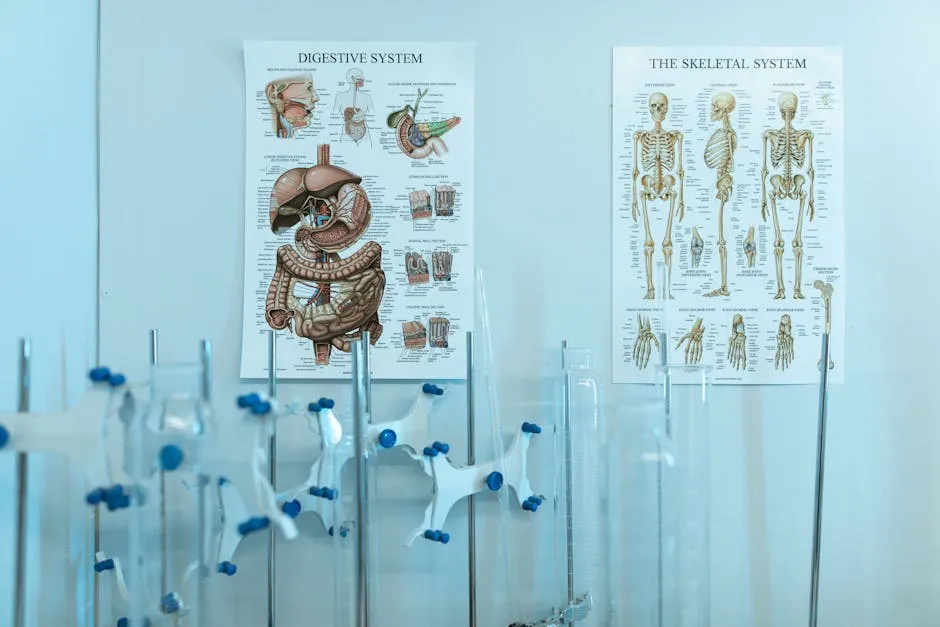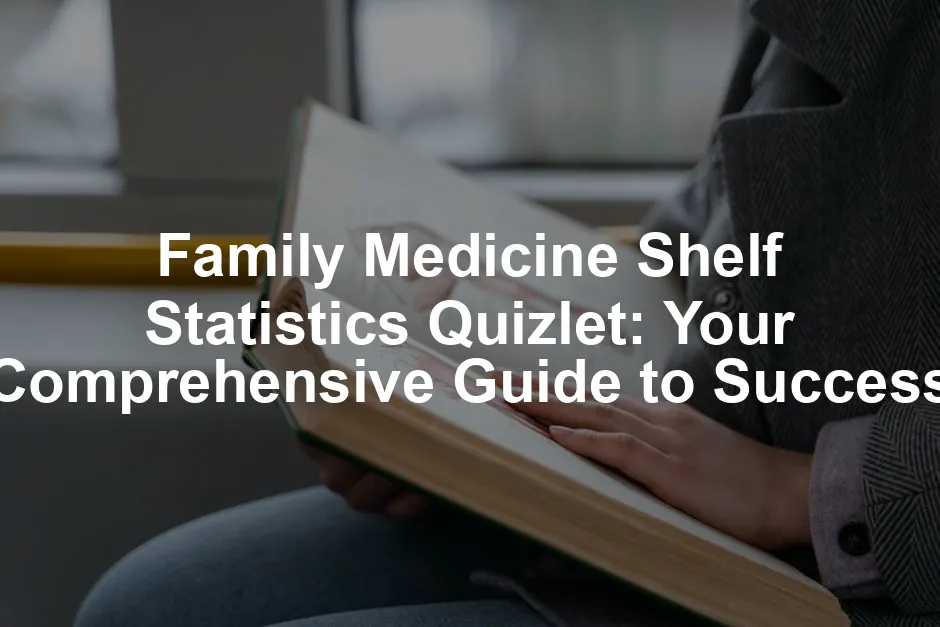Introduction
The Family Medicine Shelf Exam is a pivotal assessment in medical education. It evaluates the clinical knowledge of medical students, ensuring they are well-versed in essential family medicine principles. This exam typically takes place during clinical rotations and covers a vast array of topics, including preventive care, chronic disease management, and acute medical conditions.
Why is preparation so crucial? Well, think of this exam as your medical knowledge pop quiz, but with higher stakes. A solid performance can boost your residency applications and set the stage for your future in medicine. Enter Quizlet, a fantastic resource that can help you prepare effectively. With its flashcards and quizzes, it can make studying not just efficient but a bit more fun.
This article aims to provide insights into effective study techniques, resources like Quizlet, and tips to help you excel in the Family Medicine Shelf Exam. Let’s gear up to turn those study sessions into success stories!

Understanding the Family Medicine Shelf Exam
What is the Family Medicine Shelf Exam?
The Family Medicine Shelf Exam is a standardized test created by the National Board of Medical Examiners (NBME). It consists of multiple-choice questions designed to assess your understanding of family medicine principles. Typically, students face around 110 questions, which they have 2 hours and 45 minutes to complete. It’s a race against the clock!
Topics covered in the exam range widely. You’ll find questions on preventive care, chronic disease management, acute conditions, and much more. It’s like the buffet of medical knowledge—lots of options, but you need to know how to navigate it without getting overwhelmed.

Why is the Family Medicine Shelf Exam Important?
Why does this exam hold such weight in your medical career? For starters, it evaluates your clinical knowledge and decision-making skills. You’ll need to demonstrate your ability to manage common conditions and make sound clinical judgments.
Moreover, your score can significantly influence your residency applications. A strong performance can set you apart, showcasing your readiness for the challenges of medical practice. Think of it as your ticket to the next stage of your medical career. The better prepared you are, the more confident you’ll feel stepping into that exam room.

Key Topics Covered in the Family Medicine Shelf Exam
Preventive Care
Preventive care is the cornerstone of family medicine. It focuses on keeping patients healthy and preventing diseases before they occur. One major element is immunization schedules. The CDC provides guidelines on vaccines for all age groups, ensuring that children and adults receive necessary vaccinations. For example, the Hepatitis B vaccine is recommended for newborns, with a series of doses given in the first year.
Screening recommendations are another essential aspect. The U.S. Preventive Services Task Force (USPSTF) suggests regular screenings for conditions like colorectal cancer starting at age 45. These screenings can catch diseases early, often before symptoms arise.
Patient education is vital in preventive medicine. Providers must inform patients about the importance of vaccinations and screenings. A well-informed patient is more likely to adhere to preventive measures, leading to better health outcomes. Engaging patients in discussions about their health fosters a proactive approach to wellness.

Chronic Disease Management
Chronic diseases pose significant challenges in family medicine. Common conditions include hypertension and diabetes. Managing these requires a multifaceted approach. For hypertension, lifestyle modifications like weight loss, a DASH diet, and regular exercise are crucial. These changes can significantly lower blood pressure and reduce the risk of complications. Want to spice up your meal prep? Check out this DASH Diet Cookbook for delicious recipes that make healthy eating a breeze!
In diabetes management, monitoring blood glucose levels is key. Patients should also be educated on carbohydrate counting and the importance of regular physical activity. Medication adherence is another critical component. Healthcare providers must ensure patients understand their treatment plans, including medication timing and potential side effects.
Regular follow-ups help track progress and make necessary adjustments. This ongoing relationship between patient and provider is essential for effective chronic disease management.

Acute Care
Acute care in family medicine involves addressing sudden health issues that require immediate attention. Common conditions include respiratory infections, injuries, and gastrointestinal disturbances. Quick clinical reasoning is essential for accurate diagnoses. For instance, distinguishing between bacterial and viral infections can guide appropriate treatment.
Providers often face challenges in acute situations where time is limited. The ability to think critically and act swiftly can make a significant difference. For example, when dealing with a patient presenting with chest pain, a family physician must quickly assess the situation to rule out a heart attack versus other causes.
Managing acute cases also involves patient education. After treatment, providers should inform patients about warning signs that may require further medical attention. This approach ensures patients feel empowered and knowledgeable about their health, enhancing their recovery process.

Maternal and Child Health
Maternal and child health is a vital area in family medicine. Prenatal care involves regular check-ups to monitor both maternal and fetal health. Key considerations include nutrition, screening for gestational diabetes, and managing any pre-existing conditions. Providers should emphasize the importance of prenatal vitamins, including folic acid, to promote fetal development. Consider adding Folic Acid Supplements to your daily routine for that extra boost!
In pediatric care, regular well-child visits are essential. These visits allow for monitoring growth, development, and vaccination schedules. Childhood vaccinations protect against severe diseases like measles and whooping cough. Parents need to understand the significance of following the recommended vaccination timeline.
Common pediatric conditions include otitis media and asthma. Educating parents on recognizing early symptoms can lead to timely interventions. By fostering a supportive environment, family physicians can ensure both mothers and children receive the comprehensive care they deserve.
By mastering these key topics, you’ll be well-prepared for the Family Medicine Shelf Exam and ready to tackle the diverse challenges in family medicine practice.

Geriatric Medicine
As we age, our healthcare needs change significantly. Geriatric medicine focuses on providing tailored care for older adults, addressing their unique requirements. This specialized field acknowledges that aging can bring a host of health issues, from mobility challenges to cognitive decline. It’s not just about treating diseases; it’s about improving quality of life.
Managing polypharmacy is a critical aspect of geriatric medicine. Older adults often take multiple medications, increasing the risk of adverse effects. Each pill can come with a side of confusion or dizziness. Physicians must carefully review medications, balancing benefits against risks. A thoughtful approach can prevent harmful interactions and improve adherence.
Geriatric syndromes, like falls or incontinence, also require special attention. These conditions often stem from a combination of factors, making straightforward diagnoses tricky. A comprehensive assessment is essential. Healthcare professionals need to consider social, physical, and environmental aspects. By addressing these syndromes holistically, we can help older adults maintain their independence and dignity.

Effective Study Strategies for the Family Medicine Shelf Exam
Utilizing Quizlet for Study
Quizlet can be your study buddy for mastering the Family Medicine Shelf Exam. By creating or utilizing flashcards, you can boost your memorization and recall skills. These flashcards are perfect for quick reviews during breaks or before bed.
To make the most of Quizlet, tailor your decks to your learning preferences. Want to focus on hypertension management? Create a custom deck just for that! Personalizing your study material allows you to reinforce concepts that need extra attention. The more you engage with the material, the better you’ll remember it.

Using resources like Quizlet can enhance your study sessions significantly. family medicine shelf statistics quizlet
Active Learning Techniques
Active learning keeps your brain buzzing and engaged. Instead of passively reading, dive into practice questions and group studies. Use clinical case scenarios to connect theory with real-life applications. This method not only reinforces your knowledge but also enhances critical thinking skills.
Group studies can add a fun twist to your learning. Discussing concepts with peers can clarify doubts and provide new perspectives. Plus, it’s a great way to stay motivated! Challenge each other with questions and share tips. Remember, teaching others is one of the best ways to solidify your understanding.

Time Management and Study Schedule
Time management is crucial when preparing for your exam. Create a structured study plan that breaks down topics into manageable chunks. By allocating specific time slots for each subject, you can avoid last-minute cramming.
Integrate study sessions into your daily routine. Whether it’s reviewing flashcards during your commute or dedicating weekends to practice exams, consistency is key. Life can get busy, but by making studying a priority, you’ll feel more prepared and less stressed as exam day approaches.

Recommended Resources
High-yield resources can elevate your study game. Consider utilizing UWorld, Case Files, and the AAFP Family Medicine Board Review question bank. These tools provide realistic practice questions that mimic the shelf exam format.
Don’t underestimate the power of multimedia. Videos and podcasts can supplement your reading and help reinforce concepts. For instance, Emma Holiday’s Clerkship Review videos cover high-yield topics in an engaging way. Use these varied resources to create a well-rounded study experience.
By using these strategies and resources, you’ll be well on your way to acing the Family Medicine Shelf Exam. Remember, studying is not just about memorizing; it’s about understanding and applying your knowledge effectively. Good luck!

Recommended Resources
When gearing up for the Family Medicine Shelf Exam, the right resources can make all the difference. High-yield materials are your best friends. Start with UWorld, known for its extensive question bank. It’s like the Swiss Army knife of exam prep—multi-functional and highly effective. Case Files is another gem, offering case-based learning that mirrors real-life scenarios. This resource will help you connect theory to practice.
Don’t overlook the AAFP (American Academy of Family Physicians) resources. Their question bank is tailored for family medicine, providing relevant questions that help solidify your understanding.
Flashcards are essential too! Quizlet is a popular choice for creating and sharing decks. You can find high-yield flashcards covering everything from immunization schedules to hypertension management. For a visual learner, Emma Holiday’s Clerkship Review videos present high-yield topics in a fun, engaging way.
Textbooks also have their place. “Step Up to Medicine” offers a thorough overview of key concepts. Pair this with “Clinical Reasoning Cases in Nursing” for a practical approach to case studies. The combination of these resources will ensure you’re well-rounded in your preparation.

Common Pitfalls to Avoid When Studying
Lack of Organization
Studying without a plan is like sailing without a map. You’ll end up lost and overwhelmed. Establishing a study schedule is crucial. Break your study material into bite-sized pieces. Allocate specific times for each topic. This way, you’ll avoid the last-minute panic that comes with cramming. Aim for consistency, as regular study sessions build knowledge over time. Plus, it helps to maintain a steady pace, ensuring you cover everything without feeling rushed.

Relying Solely on Memorization
Memorizing facts is tempting, but it’s not a winning strategy. Understanding concepts is far more effective. For instance, instead of just learning the treatment for hypertension, grasp the underlying mechanisms. Why does a DASH diet lower blood pressure? When you comprehend the “why,” you’ll retain information better.
Active learning techniques, like teaching back to a peer or applying concepts to clinical scenarios, can enhance your grasp of material. Engage with the content rather than just passively reading. This approach transforms studying from a chore into an exploration of knowledge.

Ignoring Practice Questions
Practice questions are your secret weapon. Ignoring them is like going into a race without training. Exam-style questions familiarize you with the format and types of questions you’ll encounter. They help reinforce your knowledge and identify weak areas.
Utilize question banks like UWorld and the AAFP’s resources to simulate real exam conditions. Timing yourself while answering questions can improve your test-taking speed. After completing practice questions, review your answers thoroughly. Understanding why you got a question wrong is just as important as celebrating the ones you got right.
By avoiding these pitfalls, you’ll streamline your study process and enhance your understanding. Remember, preparation is key to success on the Family Medicine Shelf Exam!
Tips for Success on Exam Day
Preparing for Test Day
The day of the Family Medicine Shelf Exam can feel like a roller coaster. You want to be at your best, so let’s talk about how to prepare. First, never underestimate the power of sleep. Aim for 7 to 8 hours the night before. Your brain needs rest to function optimally. Remember, cramming until dawn won’t earn you any extra points, just bags under your eyes.
Nutrition plays a crucial role too. A healthy breakfast can boost your brainpower. Opt for protein and complex carbs—think eggs and whole-grain toast. Avoid sugary cereals that’ll send you on a sugar crash faster than a toddler after Halloween.
Stress management is equally vital. On exam day, practice some deep breathing exercises. Inhale deeply for a count of four, hold for four, and exhale for four. This technique can calm those pre-exam jitters.
Now, let’s chat about time management during the exam. A solid strategy is to make a first pass through the questions. Tackle the ones that seem straightforward first. This approach builds confidence and saves time for trickier questions later. You want to avoid the panic that comes from staring at a tough question when you could have already answered easier ones.

Post-Exam Reflection
Once you’ve completed the exam, don’t just pack your bags and run. Take a moment to reflect on your performance. Reviewing how you did is essential for future improvements. Analyze your strengths and weaknesses. Did you struggle with preventive care questions? Focus on that area next time.
Consider jotting down notes about the types of questions that challenged you. This reflection helps solidify your understanding and prepares you for future exams. With each experience, you become a more rounded, knowledgeable medical professional. So, don’t skip this crucial step! It’s all about continuous learning and growth.
FAQs
Please let us know what you think about our content by leaving a comment down below!
Thank you for reading till here 🙂
All images from Pexels




